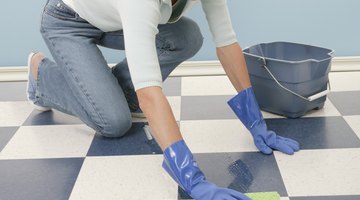Removing Tar From Floor Tiles
Tar is a thick, black substance that clings to almost anything it touches, which is unfortunate for your floors. If tar is accidentally tracked into your home, of if tar-based linoleum adhesive seeps out of a seam, you can usually remove it without special equipment, heavy labor or specialized cleaning compounds.

Tar is dissolved by oils, so most oily substances, including ordinary peanut butter, can help you remove it. Determine which type of tile you have before you start, as that will guide your selection of supplies.
Things You Will Need
- Wooden paint stir stick or craft stick
- Dull butter knife (optional)
- Butter
- Mineral oil
- Paper towels
- Degreasing floor cleaner
- White rags
- Masking tape
- Mineral spirits or turpentine
Tip
If linoleum carries a yellowish stain after you remove the tar, scrub it with a mildly abrasive nylon scrubber and commercial floor stripper. Frozen fruit treat sticks that have been washed, or their craft store counterparts, are ideal scraping tools for any kind of tile.
Warning
Wear rubber gloves when handling mineral spirits or turpentine. Ceramic or porcelain floor tiles are usually glazed, which means they are permanently sealed with a hard coating in a kiln at the factory. If yours are unsealed, rough or porous, removing the tar may be difficult or impossible. Mineral spirits and turpentine will not harm true linoleum, but they can destroy vinyl tiles. Learn which material yours are made of before proceeding. Linoleum is a solid material which is composed of small bits of color compressed together, which resemble tiny chips or flakes upon close inspection. Vinyl tiles can feature a solid color, floral patterns, geometric designs, faux wood grain or stone. Tar can permanently stain tile grout, even with vigorous cleaning. If this happens, carefully chip out the stained grout with a grout removal tool and fill the joint with fresh grout.
Ceramic, Porcelain and Vinyl Tiles
-
Scrape off as much excess tar as you can using a dull-edged tool such as a paint stirring stick or a non-serrated, dull butter knife. Knives can scratch tile, so use a light touch.
-
Apply a thick layer of butter or mineral oil on the tar stain.
-
Scrape the tile again with the dull scraping tool. Do not wipe off the oily material at this point; work it into any tar that hasn’t softened.
-
Wipe off the oily residue and loosened tar with a paper towel.
-
Apply more butter or oil to the tile if any tar remains. Let it sit for a few minutes, then scrape off the remainder of the stain.
-
Dampen a clean rag with degreasing floor cleaner.
-
Wipe the oily residue with the cleaner, turning the rag frequently, until the oil is dissolved.
-
Rinse the rag in plain water, and wipe the floor to remove all traces of cleaner.
Linoleum Tiles
-
Apply masking tape around the perimeter of the tar stain. This helps prevent spreading the stain.
-
Scrape off as much tar as you can with a wooden scraping tool such as a paint stirring stick or a wooden craft stick; metal tools can permanently scar linoleum.
-
Dampen a white rag with full-strength mineral spirits or turpentine. Solvents can cause rags with any color to deposit stains on the linoleum.
-
Wipe the tar inside the taped outline with the damp rag. Turn the rag frequently to reveal a clean side, which helps avoid redepositing or spreading the tar stain. Switch to a fresh rag as necessary, if the first one becomes covered in tar. Continue until all tar residue is removed.
-
Dampen a clean rag with plain water. Wipe the floor inside the taped outline, turning the rag frequently.
The Drip Cap
- Tar is a thick, black substance that clings to almost anything it touches, which is unfortunate for your floors.
- If tar is accidentally tracked into your home, of if tar-based linoleum adhesive seeps out of a seam, you can usually remove it without special equipment, heavy labor or specialized cleaning compounds.
- Let it sit for a few minutes, then scrape off the remainder of the stain.
- This helps prevent spreading the stain.
- Wipe the tar inside the taped outline with the damp rag.
- Switch to a fresh rag as necessary, if the first one becomes covered in tar.
References
Writer Bio
Lee Carroll has been a freelance writer for nearly a decade. Her work includes home improvement and repair, DIY projects and many other topics that help you turn your house into a comfortable home.
Photo Credits
- Comstock Images/Comstock/Getty Images
- Comstock Images/Comstock/Getty Images
More Articles



